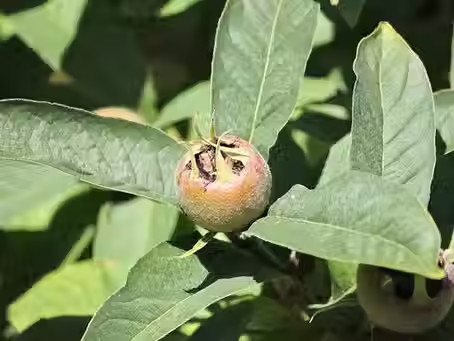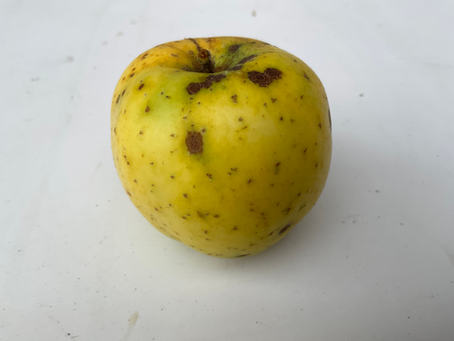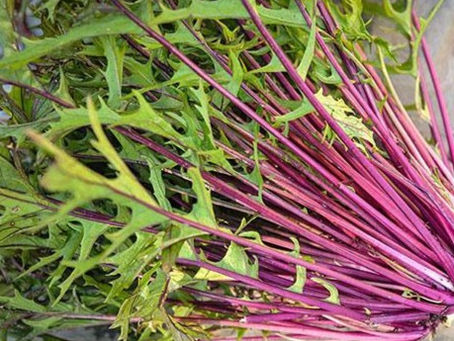top of page

pendragon orchard and vine
Turning Landscape into Legacy
Blog
Subscribe for writing that turns landscapes into legacies
Search


Defiance, Part I: The Last Apple Standing
I love this apple for its defiance. It’s the ultimate winter keeper apple. It is also one of the most balanced apples I’ve had—sweet, acidic, and without the penalty that plagues so many late hangers. The skin isn’t that tough, battlefield-leather armor you get with other winter apples. It’s firm, yes, but fair. The history, its endurance, though, makes it worth having.
Wolfy
12 hours ago4 min read


Sweet After the Freeze: Remembering Growing, and Eating the Medlar
Long after apples are gone and pears are stored away, the medlar still hangs—brown, frost-touched, and waiting. It’s a fruit that sweetens only after the cold, a reminder that not everything worth tasting comes in season.
Wolfy
Oct 134 min read


A Road Made of Roots: Notes on Wild Apples, Design, and Inheritance
I found the tree four years ago, growing out of a ditch outside Eastsound. A wild apple, balanced and bright, that led me into older work—of grafting, inheritance, and the quiet restoration that real design requires.
Wolfy
Oct 84 min read


A Strawberry Tree Grows in Seattle: Rediscovering an Ancient Evergreen — Top 10 Permaculture Species
The strawberry tree (Arbutus unedo) is an ancient evergreen too often overlooked in the Pacific Northwest. While other trees retreat into winter, it carries blossoms and ripening fruit side by side, offering color, nectar, and sustenance when little else remains. Once woven into Roman myth and Mediterranean culture, today it survives mostly as an ornamental—yet its resilience, drought tolerance, and quiet gifts make it a tree worth reclaiming for our landscapes.
Wolfy
Sep 305 min read


Edible Landscape Design with Pacific Northwest Natives: Hawthorn — Top 10 Permaculture Species
The Native Workhorse Hiding in Plain Sight Across the Pacific Northwest is, Arguably, the Ultimate Species for Edible Landscapes.
Wolfy
Sep 195 min read


Growing Olives in the Pacific Northwest: History, Survival, Struggle, and the Long Bet.
Every olive carries history in its roots — Athens crowned with Athena’s gift, Noah reading the branch as landfall, empires rising and falling while the trees still bore fruit. To plant one here is to graft that long memory into Northwest soil, a wager that what endured for millennia might endure again.
Wolfy
Sep 178 min read


Growing Wine Grapes in Seattle? Part I: Climate and Site Selection
You can grow wine grapes in Western Washington—if you pick the right varieties and stay ahead of powdery mildew. Forget the mystique; with soil, sun, water, and patience, a backyard vineyard is within reach.
Wolfy
Sep 107 min read


Growing Figs in the Pacific Northwest: A Practical Guide for Growers
Figs aren’t just for the Mediterranean. In the Pacific Northwest, a handful of hardy cultivars thrive with the right microclimate and pruning. Learn which varieties deliver, how to favor breba crops over late-ripening duds, and why now is the best time to experiment with figs in Cascadia.
Wolfy
Sep 85 min read


Edible Landscape Design: Aronia (Chokeberry) — Top 10 Permaculture Species
Why Aronia (Chokeberry) Is the Shrub That Crushes Blueberries in Nutrition, Resilience, and Design
Tamayo
Sep 34 min read


Edible Landscape Design: Russian Comfrey — Top 10 Permaculture Species
Russian comfrey isn’t a crop you grow and forget — it’s a permanent fixture in the food forest. The sterile Bocking 14 hybrid won’t spread by seed, but once rooted it becomes a long-term nutrient engine, pulling minerals from deep in the soil and cycling them into leaves you can cut again and again. We plant it around fruit trees not only for its mulch and pollinator blooms, but also as a living barrier that keeps out runner grasses.
Wolfy
Sep 13 min read


Edible Landscape Design: Jerusalem Artichoke (Sunchoke) — Top 10 Permaculture Species
A dense patch of Jerusalem artichokes with tall green stalks and bright yellow sunflower-like blooms, growing along a hillside with trees in the background.
Wolfy
Aug 293 min read


Edible Landscape Design: Hazelnut (Filbert) — Top 10 Permaculture Species
Hazelnut (filbert) is a top permaculture design species: storable calories, oil, mulch, fencing, habitat, and a living screen—all from one resilient shrub.
Wolfy
Aug 183 min read


Seriously. Stop Hard Pruning Your Fruit Trees in Winter
Pruning is not conquest. It’s a negotiation with biology. It should be a conversation across seasons. And the blade should be an instrument of guidance — never of amputation . Every winter the cycle repeats: trees pruned down to stubs, their silhouettes reduced to skeletons against the sky. Owners look on, wincing but resigned, convinced this is what stewardship demands. They’ve been told it’s gospel. They’ve been sold on myth. But in summer the truth appears. Instead of fru
Wolfy
Aug 174 min read


Exploring the Nutritional Wonders of Chokeberry: A Hidden Gem in the World of Superfoods
In the realm of superfoods, there are a few that stand out for their exceptional health benefits and remarkable nutrient content. One such unsung hero is the chokeberry (Aronia), a small dark berry that packs a powerful punch when it comes to promoting wellness and vitality. Despite its relatively low profile, chokeberry is a nutritional powerhouse that deserves a closer look. The Basics of Chokeberry: Chokeberries are native to North America and have been prized for centurie
Wolfy
Aug 15, 20232 min read


Peppers in June? Easy, They're Perennial
Here in the Maritime Northwest there are several reliable pepper varieties we can grow without climate hacking. These mostly produce fruit that are lower on the Scoville scale, as higher, generally, requires more heat units than we can offer in our local ecology without a greenhouse. While appropriate variety selection is important, you can be most successful growing peppers by planning to grow them as perennials and not annuals. Jump Start It’s June, and my first peppers, S
Wolfy
Jun 20, 20211 min read


Easy, Fresh Greens in Winter: A Guide to Maritime Northwest Winter Gardening
Wondering how to feed yourself fresh greens, berries, and fruit in the maritime northwest winter without a greenhouse or a trip to the grocery store? It's not hard; it's about appropriate species and variety selection. Our maritime climate is kind to us gardeners, and we should give thanks by growing all year long, especially in winter when food is scarce. There are less pests to worry about in winter too, and no watering. Below are some of the species and varieties that are
Wolfy
Dec 19, 20204 min read


Permaculture's A-List Species: Helianthus maximiliani, A Perennial Sunflower
In permaculture, all things should have multi-functions. Topping my list this year is a lesser known sunflower that is perennial, edible, pollinator-friendly, drought tolerant, and just beautiful. It's Helianthus maximiliani, Maximilian Sunflower. I use this species on every project, as does our charity All Hands on Earth . Seeding is easy: sprinkle on the soil and press down lightly; water regularly until the shoots, which are edible, reach about 6-8" in height. Then let it
Wolfy
Jul 19, 20191 min read


Permaculture Landscaping: Schisandra Berry (Schisandra chinensis)
Permaculture Landscaping: Schisandra Berry ( Schisandra chinensis) We installed Schisandra at two permaculture sites this week, trellising the specimens on a fence. Personally, I love climbers, and if I find a suitable fence or wall, I’ll grow vertically on it to extend its function. Schisandra, native to East Asia, is a hardy deciduous climber that can tolerate shade and grows in a variety of soils. Fitting the profile of a quintessential permaculture species, meaning multi-
Wolfy
Jun 27, 20191 min read


Permaculture Gardening and Landscaping: Yamaimo (Dioscorea japonica)
Today we installed Yamaimo (Japanese Mountain Yam) as part of a permaculture food forest and gardening project on Orcas Island. Yamaimo often makes the species list for our projects by providing a high calorie, delicious, and reliable food source. Here below we are growing Yamaimo in pots filled mostly with sand and a little dirt taken from nearby plantings. Growing in pots makes harvesting the tubers easier: you dump the pot over when you are ready to harvest and they spill
Wolfy
Jun 26, 20191 min read
bottom of page